Von Karman spatio-temporal covariance¶
This notebook contains examples on the use of the von_karman_covariance_calculator module
Spatial frequencies’ sampling for the CPSD¶
In this example, we plot the phase and Zernike CPSD before integrating them over the spatial frequencies (we consider the perpendicular component of the frequency wrt the wind vector).
The aim is to show that the phase integrand oscillates very quickly around 0 (being 0 on average) in the range of high temporal and spatial frequencies. Therefore, it is important to choose the spatial frequency range with the proper sampling in order not to overestimate the phase CPSD (e.g. good_spat_freqs = np.logspace(-3, 3, 1000)).
This is not as much important for the Zernike CPSD, because the Zernike integrand is not 0 on average in the range of high temporal and spatial frequencies (not so true…).
[24]:
import numpy as np
import astropy.units as u
from arte.types.guide_source import GuideSource
from arte.types.aperture import CircularOpticalAperture
from arte.atmo.von_karman_covariance_calculator import VonKarmanSpatioTemporalCovariance
from arte.atmo.cn2_profile import Cn2Profile
source1 = GuideSource((0*u.arcsec, 0*u.deg), np.inf*u.m)
source2 = GuideSource((50*u.arcsec, 30*u.deg), 100e3*u.m)
aperture1 = CircularOpticalAperture(5*u.m, [0, 0, 0]*u.m)
aperture2 = CircularOpticalAperture(5*u.m, [0, 0, 0]*u.m)
cn2 = Cn2Profile.from_r0s(layersR0=[16]*u.cm, layersL0=[25]*u.m, layersAltitude=[10]*u.km,
layersWindSpeed=[10]*u.m/u.s, layersWindDirection=[-20]*u.deg)
temp_freqs = np.linspace(0.05, 250, 5000)
spat_freqs = np.logspace(-3, 3, 1000)
mode_j = 2
mode_k = 5
vk = VonKarmanSpatioTemporalCovariance(source1=source1, source2=source2, aperture1=aperture1, aperture2=aperture2,
cn2_profile=cn2, spat_freqs=spat_freqs)
phaseIntegrand, _ = vk.integrandOfPhaseCPSD(nLayer=0, temp_freq=temp_freqs[4000])
zernikeIntegrand, _ = vk.integrandOfZernikeCPSD(j=mode_j, k=mode_k, nLayer=0, temp_freq=temp_freqs[4000])
Here, we plot the phase and zernike integrand functions.
[25]:
import matplotlib.pyplot as plt
import matplotlib as mpl
mpl.rcParams['figure.dpi'] = 150
plt.figure()
plt.semilogx(spat_freqs, np.real(phaseIntegrand))
plt.xlabel('f${\perp}$ [m$^{-1}$]')
plt.ylabel('Integrand Function [m$\cdot$rad$^{2}$/Hz]')
plt.title('Phase')
plt.figure()
plt.semilogx(spat_freqs, np.real(zernikeIntegrand))
plt.xlabel('f${\perp}$ [m$^{-1}$]')
plt.ylabel('Integrand Function [m$\cdot$rad$^{2}$/Hz]')
plt.title('Zernike')
[25]:
Text(0.5, 1.0, 'Zernike')
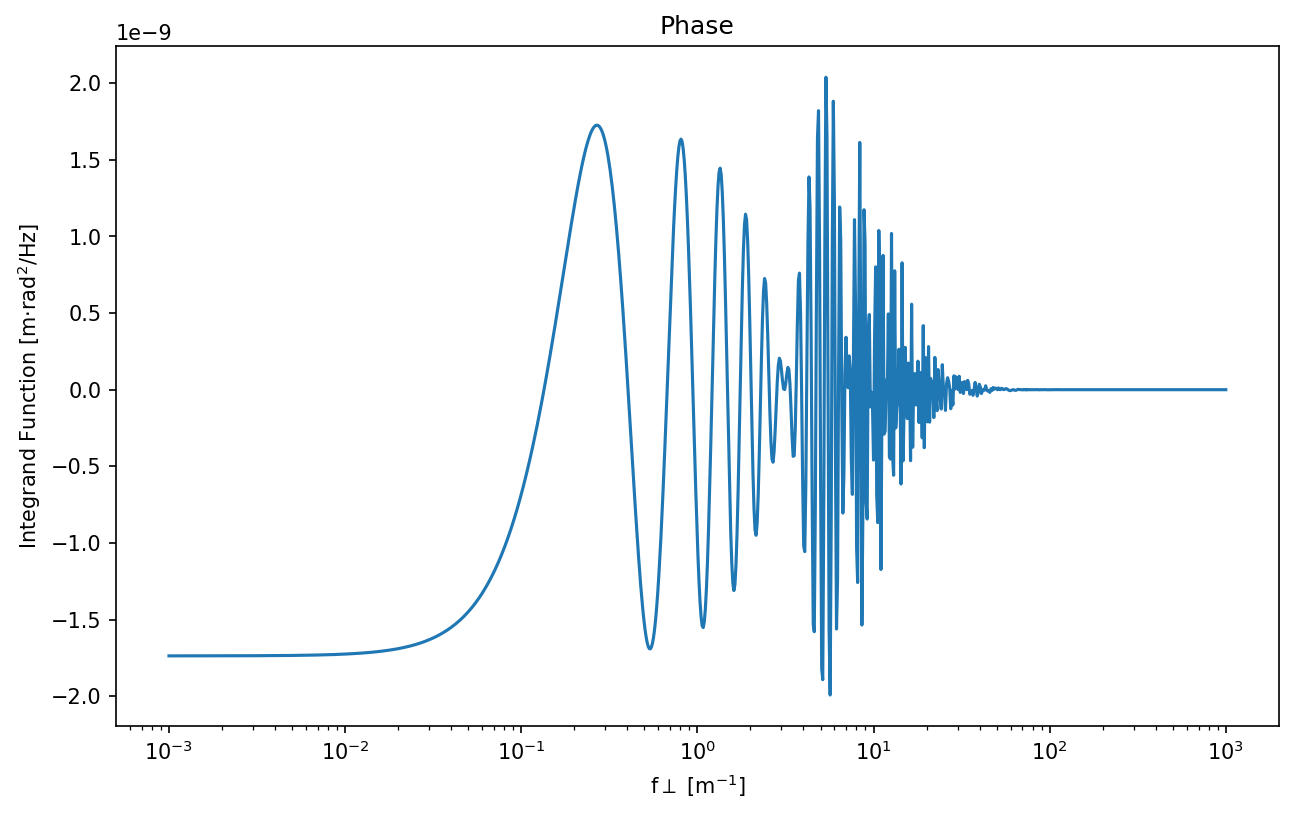
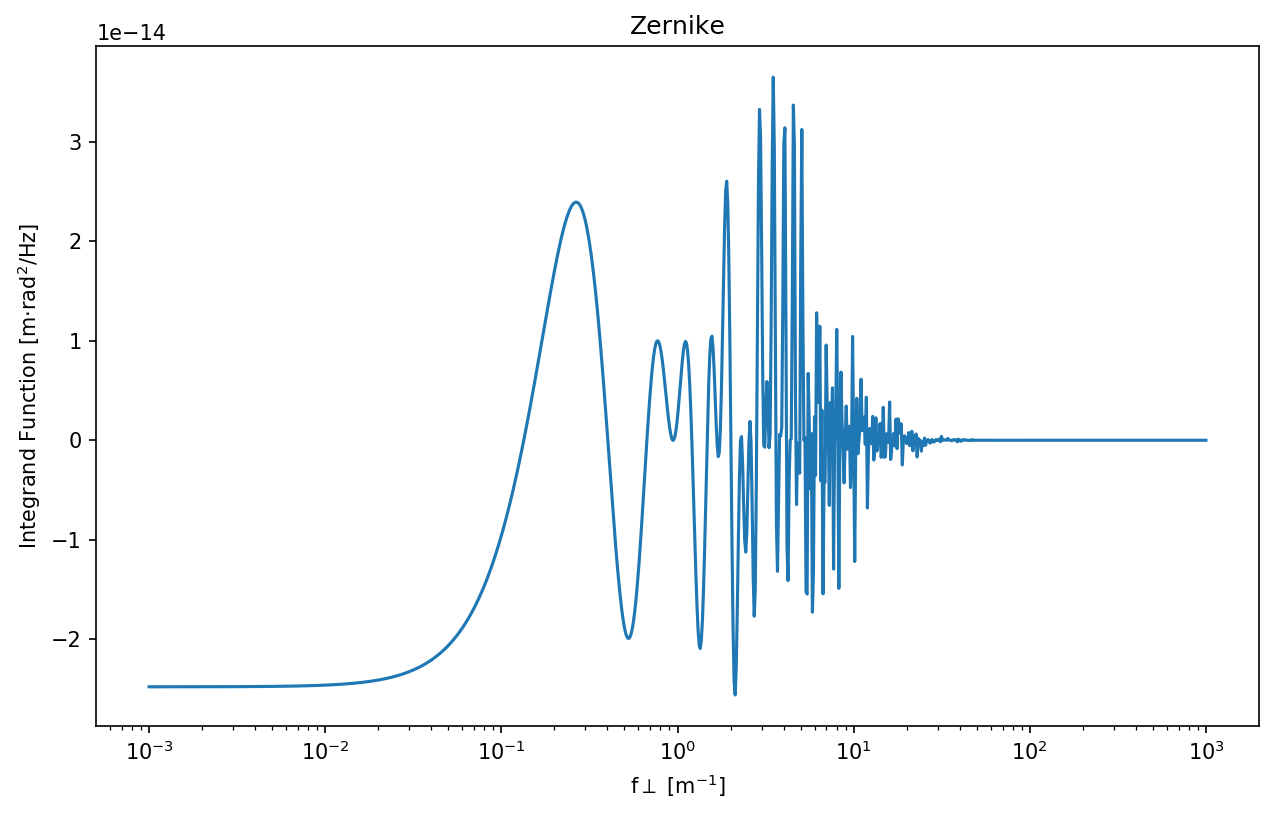
[26]:
mode_j = 2
mode_k = 5
vk.setSpatialFrequencies(spat_freqs)
phaseCpsdGoodSampling = vk.getPhaseCPSD(temp_freqs=temp_freqs)
zernikeCpsdGoodSampling = vk.getZernikeCPSD(j=mode_j, k=mode_k, temp_freqs=temp_freqs)
spat_freqs_bad_sampling = np.logspace(-3, 3, 100)
vk.setSpatialFrequencies(spat_freqs_bad_sampling)
phaseCpsdBadSampling = vk.getPhaseCPSD(temp_freqs)
zernikeCpsdBadSampling = vk.getZernikeCPSD(j=mode_j, k=mode_k, temp_freqs=temp_freqs)
Here, we plot the phase and zernike CPSD. We can see that the sampling choice has a large effect on the phase CPSD.
[27]:
plt.figure()
vk.plotCPSD(phaseCpsdGoodSampling, temp_freqs, 'real', 'log', legend='Phase CPSD with good spatial frequency sampling', wavelength=5e-7)
vk.plotCPSD(phaseCpsdBadSampling, temp_freqs, 'real', 'log', legend='Phase CPSD with bad spatial frequency sampling',wavelength=5e-7)
plt.title('Phase')
plt.figure()
vk.plotCPSD(zernikeCpsdGoodSampling, temp_freqs, 'real', 'log', legend='<z2,z5> with good spatial frequency sampling',wavelength=5e-7)
vk.plotCPSD(zernikeCpsdBadSampling, temp_freqs, 'real', 'log', legend='<z2,z5> with bad spatial frequency sampling', wavelength=5e-7)
plt.title('Zernike')
[27]:
Text(0.5, 1.0, 'Zernike')


Test against alternative code¶
A simple check against IDL oaa_lib developed in Arcetri. The variance of tilt for a D=10m telescope, with L0=25m and r0=0.16m @ 500nm is
IDL> d=10. & L0=25. & r0=0.16 & scale=(d/r0)^(5./3) & L0n=L0/d
IDL> sqrt(von_covar(2, 2 , L0n) * scale) * 500
544.88968962380648
Below we reproduce the same result
[28]:
import astropy.units as u
source = GuideSource((0, 0), np.inf)
aperture = CircularOpticalAperture(5, [0, 0, 0])
cn2 = Cn2Profile.from_r0s(layersR0=[0.16], layersL0=[25], layersAltitude=[100],
layersWindSpeed=[10], layersWindDirection=[-20])
temp_freqs = np.linspace(0.05, 250, 5000)
spat_freqs = np.logspace(-3, 3, 1000)
vk = VonKarmanSpatioTemporalCovariance(source1=source, source2=source, aperture1=aperture, aperture2=aperture,
cn2_profile=cn2, spat_freqs=spat_freqs)
dum = vk.getZernikeCovariance(j=2, k=2)
print(np.sqrt(np.abs(dum)) * (500*u.nm / (2*np.pi*u.rad)))
544.9482889137599 nm
Test the comparison between covariance and integrated CPSD¶
[29]:
import numpy as np
from arte.types.guide_source import GuideSource
from arte.types.aperture import CircularOpticalAperture
from arte.atmo.cn2_profile import Cn2Profile
from arte.atmo.von_karman_covariance_calculator import VonKarmanSpatioTemporalCovariance
source = GuideSource((0, 0), np.inf)
aperture1 = CircularOpticalAperture(5, [0, 0, 0])
aperture2 = CircularOpticalAperture(5, [0, 0, 0])
cn2_profile = Cn2Profile.from_r0s([0.16], [25], [10e3], [10], [-20])
spatial_freqs = np.logspace(-4, 4, 1000)
#temp_freqs = np.linspace(0.05, 250, 5000)
temp_freqs = np.logspace(-3, 3, 1000)
vk = VonKarmanSpatioTemporalCovariance(source1=source, source2=source, aperture1=aperture1, aperture2=aperture2,
cn2_profile=cn2_profile, spat_freqs=spatial_freqs)
phaseCovariance = vk.getPhaseCovariance()
phaseCPSD = vk.getPhaseCPSD(temp_freqs)
import astropy.units as u
phaseCovFromCPSD = np.trapz(2*np.real(phaseCPSD) ,temp_freqs*u.Hz)
[30]:
print('Phase covariance: {}'.format(phaseCovariance))
print('Phase covariance from CPSD integration: {}'.format(phaseCovFromCPSD))
print('Ratio: {}'.format(phaseCovariance/phaseCovFromCPSD))
Phase covariance: (190.1521316706498+0j) rad2
Phase covariance from CPSD integration: 189.80279499246706 rad2
Ratio: (1.0018405244148096+0j)
[31]:
zernikeCovariance = vk.getZernikeCovariance(2, 2)
zernikeCPSD = vk.getZernikeCPSD(2, 2, temp_freqs)
zernikeGeneralCPSD = vk.getGeneralZernikeCPSD(2, 2, temp_freqs)
zernikeCovFromCPSD = 2 * np.trapz(np.real(zernikeCPSD), temp_freqs * u.Hz)
zernikeCovFromGeneralCPSD = np.trapz(zernikeGeneralCPSD, temp_freqs * u.Hz)
[46]:
print('Zernike covariance: {}'.format(zernikeCovariance))
print('Zernike covariance from CPSD integration: {}'.format(zernikeCovFromCPSD))
#print('Zernike covariance from general CPSD integration: {}'.format(zernikeCovFromGeneralCPSD))
print('Ratio: {}'.format(zernikeCovariance/zernikeCovFromCPSD))
Zernike covariance: (46.89658274854332+0j) rad2
Zernike covariance from CPSD integration: 46.772634330233146 rad2
Ratio: (1.002650020040245+0j)
Zernike correlation and residuals as a function of off-axis guide star angular distance¶
[33]:
import numpy as np
import astropy.units as u
from arte.types.guide_source import GuideSource
from arte.types.aperture import CircularOpticalAperture
from arte.atmo.von_karman_covariance_calculator import VonKarmanSpatioTemporalCovariance
from arte.atmo.cn2_profile import Cn2Profile
cn2 = Cn2Profile.from_r0s([16]*u.cm, [25]*u.m, [10]*u.km, [10]*u.m/u.s, [-20]*u.deg)
sourceOnAxis = GuideSource((0*u.arcsec, 0*u.deg), np.inf*u.m)
aperture1 = CircularOpticalAperture(5*u.m, [0, 0, 0]*u.m)
aperture2 = CircularOpticalAperture(5*u.m, [0, 0, 0]*u.m)
spatial_freqs = np.logspace(-3, 3, 100)
[34]:
def correlationParameter(cov_onon, cov_onoff):
return cov_onoff/cov_onon
def correlationParameterVsAngularDistance(distance_range, j, k):
vk = VonKarmanSpatioTemporalCovariance(source1=sourceOnAxis, source2=sourceOnAxis, aperture1=aperture1,
aperture2=aperture2, cn2_profile=cn2, spat_freqs=spatial_freqs)
covOnOn = vk.getZernikeCovariance(j,k)
correlationParams = []
for i in distance_range:
sourceOff = GuideSource((i*u.arcsec, 0*u.deg), np.inf*u.m)
vk.setSource2(sourceOff)
covOnOff = vk.getZernikeCovariance(j,k)
corr = correlationParameter(covOnOn, covOnOff)
correlationParams.append(corr)
return correlationParams, covOnOn
def residualOfCorrectionUsingOffAxisGuideStar(correlationParameter, cov_onon):
sigma_res = np.sqrt(2*(1 - correlationParameter)*cov_onon)
return sigma_res
def correlationParameterVsOuterScale(outer_scales, j, k):
vk = VonKarmanSpatioTemporalCovariance(source1=sourceOnAxis, source2=sourceOnAxis, aperture1=aperture1,
aperture2=aperture2, cn2_profile=cn2, spat_freqs=spatial_freqs)
for L0 in outer_scales:
cn2 = Cn2Profile.from_r0s([16]*u.cm, [L0]*u.m, [10]*u.km, [10]*u.m/u.s, [-20]*u.deg)
vk.setCn2Profile(cn2)
correlation = correlationParameterVsAngularDistance()
return correlationParams, covOnOn
[35]:
distances = np.arange(0, 600)
correlation22, covOnOn22 = correlationParameterVsAngularDistance(distances, 2, 2)
correlation33,covOnOn33 = correlationParameterVsAngularDistance(distances, 3, 3)
correlation44, covOnOn44 = correlationParameterVsAngularDistance(distances, 4, 4)
correlation88, covOnOn88 = correlationParameterVsAngularDistance(distances, 8, 8)
import matplotlib.pyplot as plt
plt.rcParams["figure.figsize"] = (10,6)
plt.plot(distances, np.real(correlation22), label='Tip')
plt.plot(distances, np.real(correlation33), label='Tilt')
plt.plot(distances, np.real(correlation44), label='Focus')
plt.plot(distances, np.real(correlation88), label='Coma')
plt.xlabel('Angular Distance [arcsec]')
plt.ylabel('Correlation')
plt.legend()
plt.grid()
plt.show()

[36]:
res22 = np.array([residualOfCorrectionUsingOffAxisGuideStar(corr, covOnOn22) for corr in correlation22])
res33 = np.array([residualOfCorrectionUsingOffAxisGuideStar(corr, covOnOn33) for corr in correlation33])
res44 = np.array([residualOfCorrectionUsingOffAxisGuideStar(corr, covOnOn44) for corr in correlation44])
res88 = np.array([residualOfCorrectionUsingOffAxisGuideStar(corr, covOnOn88) for corr in correlation88])
saturationRes22 = np.ones(distances.shape)*residualOfCorrectionUsingOffAxisGuideStar(0, covOnOn22)
saturationRes33 = np.ones(distances.shape)*residualOfCorrectionUsingOffAxisGuideStar(0, covOnOn33)
saturationRes44 = np.ones(distances.shape)*residualOfCorrectionUsingOffAxisGuideStar(0, covOnOn44)
saturationRes88 = np.ones(distances.shape)*residualOfCorrectionUsingOffAxisGuideStar(0, covOnOn88)
cycle = plt.rcParams['axes.prop_cycle'].by_key()['color']
plt.rcParams["figure.figsize"] = (10,6)
plt.plot(distances, np.real(res22), label='Tip', color=cycle[0])
plt.plot(distances, np.real(saturationRes22), '-.', color=cycle[0])
plt.plot(distances, np.real(res33), label='Tilt', color=cycle[1])
plt.plot(distances, np.real(saturationRes33), '-.', color=cycle[1])
plt.plot(distances, np.real(res44), label='Focus', color=cycle[2])
plt.plot(distances, np.real(saturationRes44), '-.', color=cycle[2])
plt.plot(distances, np.real(res88), label='Coma', color=cycle[3])
plt.plot(distances, np.real(saturationRes88), '-.', color=cycle[3])
plt.xlabel('Angular Distance [arcsec]')
plt.ylabel('$\sigma_{res}$')
plt.legend()
plt.grid()
plt.show()
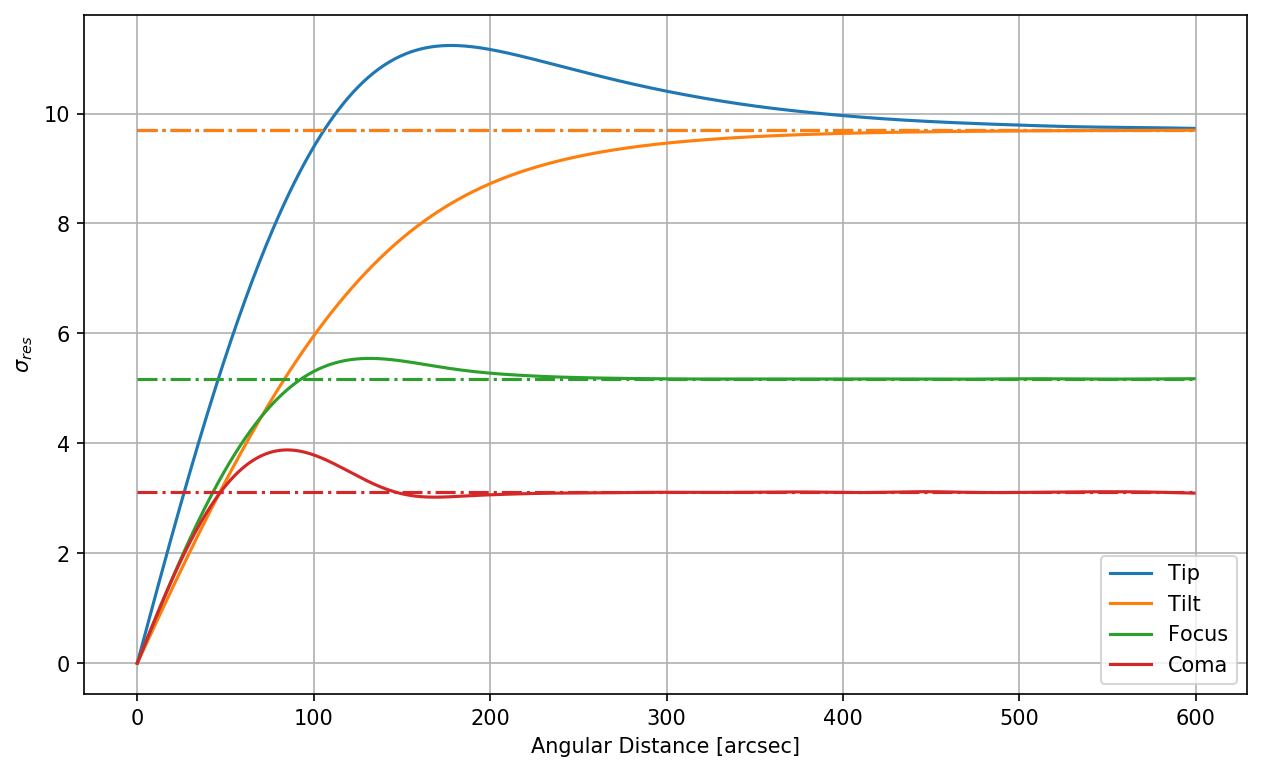
Cutoff frequency of Zernike CPSD using one source at infinity and one aperture¶
If we consider one source at infinity and one aperture, the cutoff frequency of Zernike CPSD depends on the Zernike radial degree \(n\), the wind velocity \(V\) and the aperture diameter \(D\) according to this relationship (J.M.Conan, 1995): \(\nu_{c} \sim 0.3 (n+1)V/D\)
Here, we test the dependence on the Zernike radial degree \(n\).
[37]:
import numpy as np
from arte.types.guide_source import GuideSource
from arte.types.aperture import CircularOpticalAperture
from arte.atmo.von_karman_covariance_calculator import VonKarmanSpatioTemporalCovariance
from arte.atmo.cn2_profile import Cn2Profile
rho, theta = (0,0)
aperture_radius = 5
aperture_centre = [0, 0, 0]
r0 = [0.16]
L0 = [25]
layers_altitude = [10e3]
wind_speed = [10]
wind_direction = [0]
source = GuideSource((rho, theta), np.inf)
aperture = CircularOpticalAperture(aperture_radius, aperture_centre)
cn2 = Cn2Profile.from_r0s(r0, L0, layers_altitude, wind_speed, wind_direction)
spatial_freqs = np.logspace(-3, 3, 100)
temporal_freqs = np.linspace(0.05, 250, 5000)
vk = VonKarmanSpatioTemporalCovariance(source1=source, source2=source, aperture1=aperture, aperture2=aperture,
cn2_profile=cn2, spat_freqs=spatial_freqs)
zz22 = vk.getZernikeCPSD(2, 2, temporal_freqs)
zz88 = vk.getZernikeCPSD(8, 8, temporal_freqs)
zz22_22 = vk.getZernikeCPSD(22, 22, temporal_freqs)
cutoff22 = temporal_freqs[11]
cutoff88 = temporal_freqs[23]
cutoff22_22 = temporal_freqs[41]
[38]:
plt.rcParams["figure.figsize"] = (10,6)
vk.plotCPSD(zz22, temporal_freqs, 'real', 'log', '(2,2) v$_{l}$ = 10 m/s')
vk.plotCPSD(zz88, temporal_freqs, 'real', 'log', '(8,8) v$_{l}$ = 10 m/s')
vk.plotCPSD(zz22_22, temporal_freqs, 'real', 'log', '(22,22) v$_{l}$ = 10 m/s')
import matplotlib.pyplot as plt
cycle = plt.rcParams['axes.prop_cycle'].by_key()['color']
plt.axvline(cutoff22, linestyle='-.', color=cycle[0])
plt.axvline(cutoff88, linestyle='-.', color=cycle[1])
plt.axvline(cutoff22_22, linestyle='-.', color=cycle[2])
[38]:
<matplotlib.lines.Line2D at 0x821041710>

Here, we test the dependence on the wind velocity.
[39]:
wind_velocities = np.array([10, 30, 50])
j = 2
k = 2
zernikeCpsds = []
for v in wind_velocities:
cn2 = Cn2Profile.from_r0s([0.16], [25], [10e3], [v], [0])
vk.setCn2Profile(cn2)
cpsd = vk.getZernikeCPSD(j, k, temporal_freqs)
zernikeCpsds.append(cpsd)
vk.plotCPSD(zernikeCpsds[0], temporal_freqs, 'real', 'log', '(2,2) v$_{l}$ = 10 m/s')
vk.plotCPSD(zernikeCpsds[1], temporal_freqs, 'real', 'log', '(2,2) v$_{l}$ = 30 m/s')
vk.plotCPSD(zernikeCpsds[2], temporal_freqs, 'real', 'log', '(2,2) v$_{l}$ = 50 m/s')
cutoff_v1 = temporal_freqs[11]
cutoff_v2 = temporal_freqs[35]
cutoff_v3 = temporal_freqs[59]
plt.axvline(cutoff_v1, linestyle='-.', color=cycle[0])
plt.axvline(cutoff_v2, linestyle='-.', color=cycle[1])
plt.axvline(cutoff_v3, linestyle='-.', color=cycle[2])
[39]:
<matplotlib.lines.Line2D at 0x821332e10>
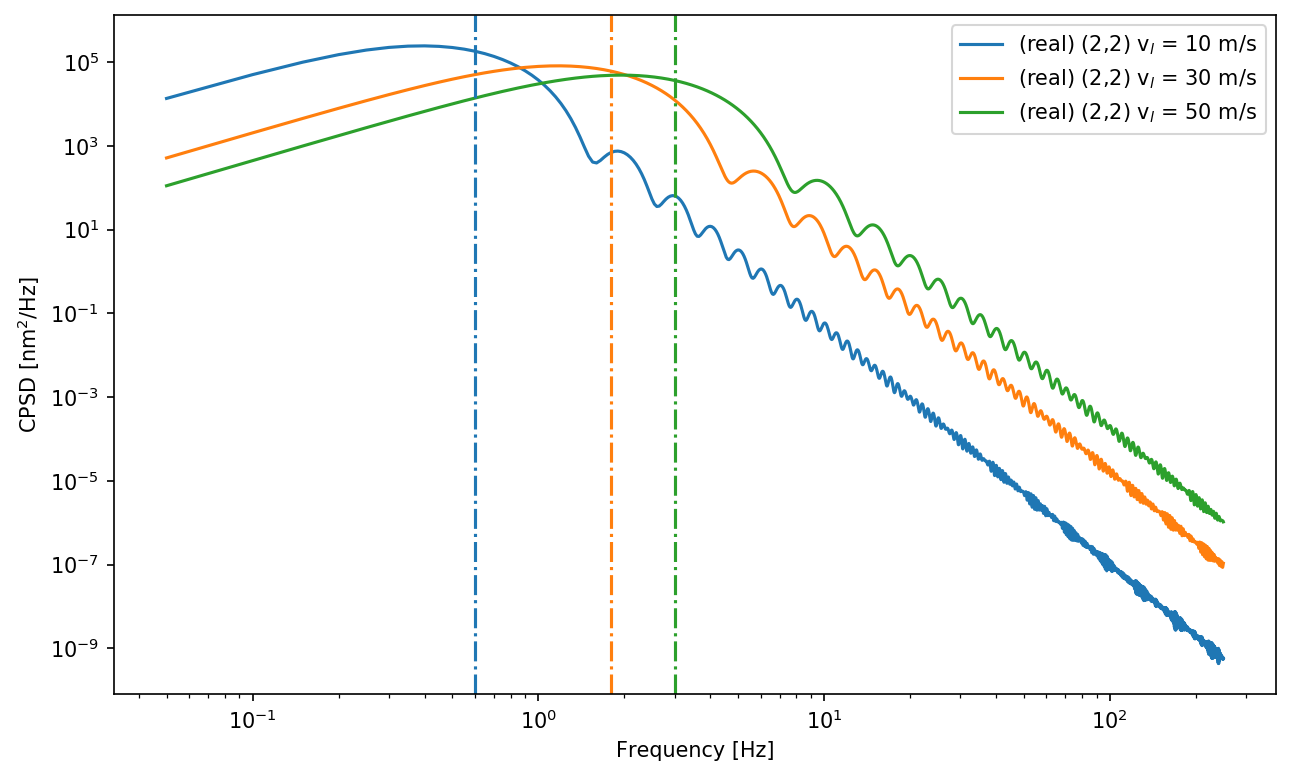
Here, we test the dependence on the aperture diameter.
[40]:
cn2 = Cn2Profile.from_r0s([0.16], [25], [10e3], [10], [0])
vk.setCn2Profile(cn2)
aperture_diameters = np.array([10, 20, 40])
j = 2
k = 2
zernikeCpsds = []
for d in aperture_diameters:
aperture = CircularOpticalAperture(d/2, [0, 0, 0])
vk.setAperture1(aperture)
vk.setAperture2(aperture)
cpsd = vk.getZernikeCPSD(j, k, temporal_freqs)
zernikeCpsds.append(cpsd)
vk.plotCPSD(zernikeCpsds[0], temporal_freqs, 'real', 'log', '(2,2) D = 10 m, v$_{l}$ = 10 m/s')
vk.plotCPSD(zernikeCpsds[1], temporal_freqs, 'real', 'log', '(2,2) D = 20 m, v$_{l}$ = 10 m/s')
vk.plotCPSD(zernikeCpsds[2], temporal_freqs, 'real', 'log', '(2,2) D = 40 m, v$_{l}$ = 10 m/s')
cutoff_d1 = temporal_freqs[11]
cutoff_d2 = temporal_freqs[5]
cutoff_d3 = temporal_freqs[2]
plt.axvline(cutoff_d1, linestyle='-.', color=cycle[0])
plt.axvline(cutoff_d2, linestyle='-.', color=cycle[1])
plt.axvline(cutoff_d3, linestyle='-.', color=cycle[2])
[40]:
<matplotlib.lines.Line2D at 0x81f045dd8>
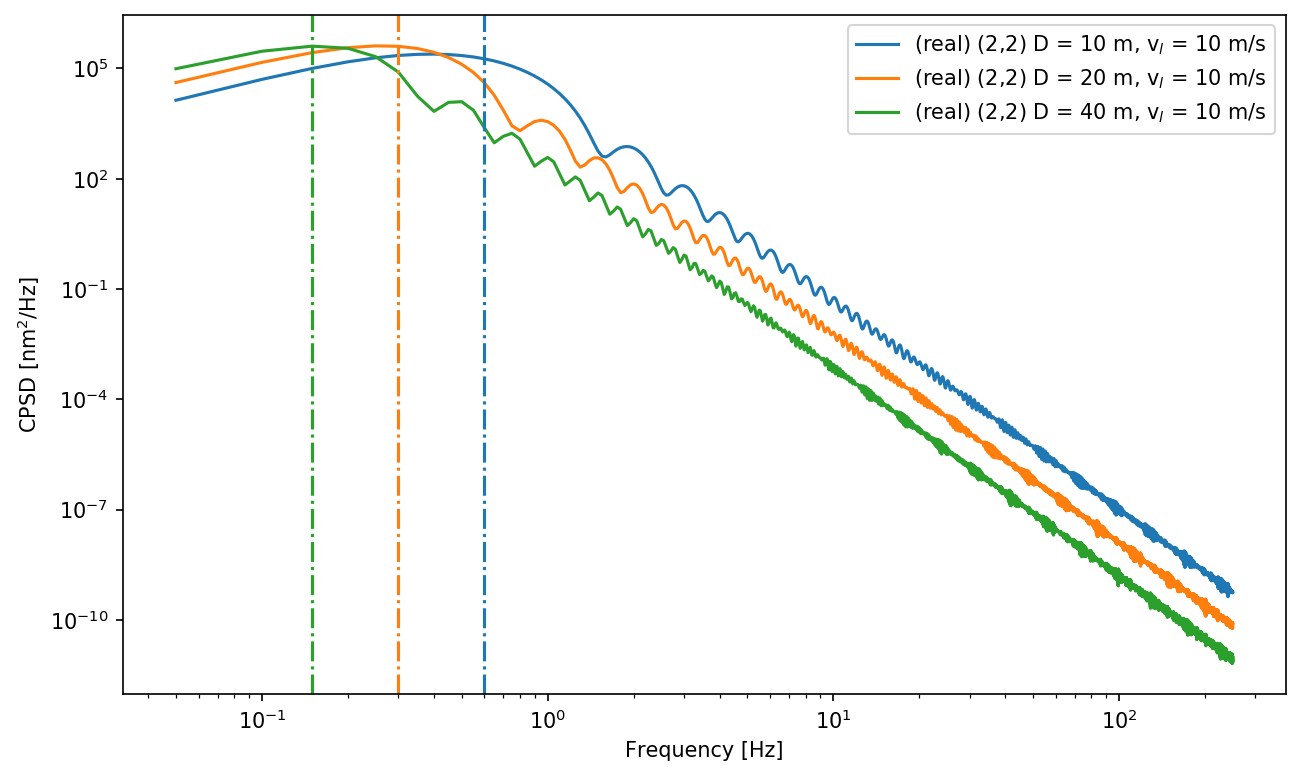
Slope of Zernike CPSD at high temporal frequencies¶
[41]:
import numpy as np
from arte.types.guide_source import GuideSource
from arte.types.aperture import CircularOpticalAperture
from arte.atmo.von_karman_covariance_calculator import VonKarmanSpatioTemporalCovariance
from arte.atmo.cn2_profile import Cn2Profile
rho, theta = (0,0)
aperture_radius = 5
aperture_centre = [0, 0, 0]
r0 = [0.16]
L0 = [25]
layers_altitude = [10e3]
wind_speed = [10]
wind_direction = [0]
source = GuideSource((rho, theta), np.inf)
aperture = CircularOpticalAperture(aperture_radius, aperture_centre)
cn2 = Cn2Profile.from_r0s(r0, L0, layers_altitude, wind_speed, wind_direction)
spatial_freqs = np.logspace(-3, 3, 100)
temporal_freqs = np.linspace(0.05, 250, 5000)
vk = VonKarmanSpatioTemporalCovariance(source1=source, source2=source, aperture1=aperture, aperture2=aperture,
cn2_profile=cn2, spat_freqs=spatial_freqs)
zz22 = vk.getZernikeCPSD(2, 2, temporal_freqs)
zz88 = vk.getZernikeCPSD(8, 8, temporal_freqs)
zz22_22 = vk.getZernikeCPSD(22, 22, temporal_freqs)
[42]:
plt.figure()
vk.plotCPSD(zz22, temporal_freqs, 'real', 'log', '(2,2)')
vk.plotCPSD(zz88, temporal_freqs, 'real', 'log', '(8,8)')
vk.plotCPSD(zz22_22, temporal_freqs, 'real', 'log', '(22,22)')
def slope(x, m, q):
return q*x**(m)
theor_slope = slope(temporal_freqs, -17./3, 1e5)
plt.loglog(temporal_freqs, theor_slope, '-.', label='Theoretical power law $\\nu^{-17/3}$')
plt.legend()
[42]:
<matplotlib.legend.Legend at 0x8247e2c18>
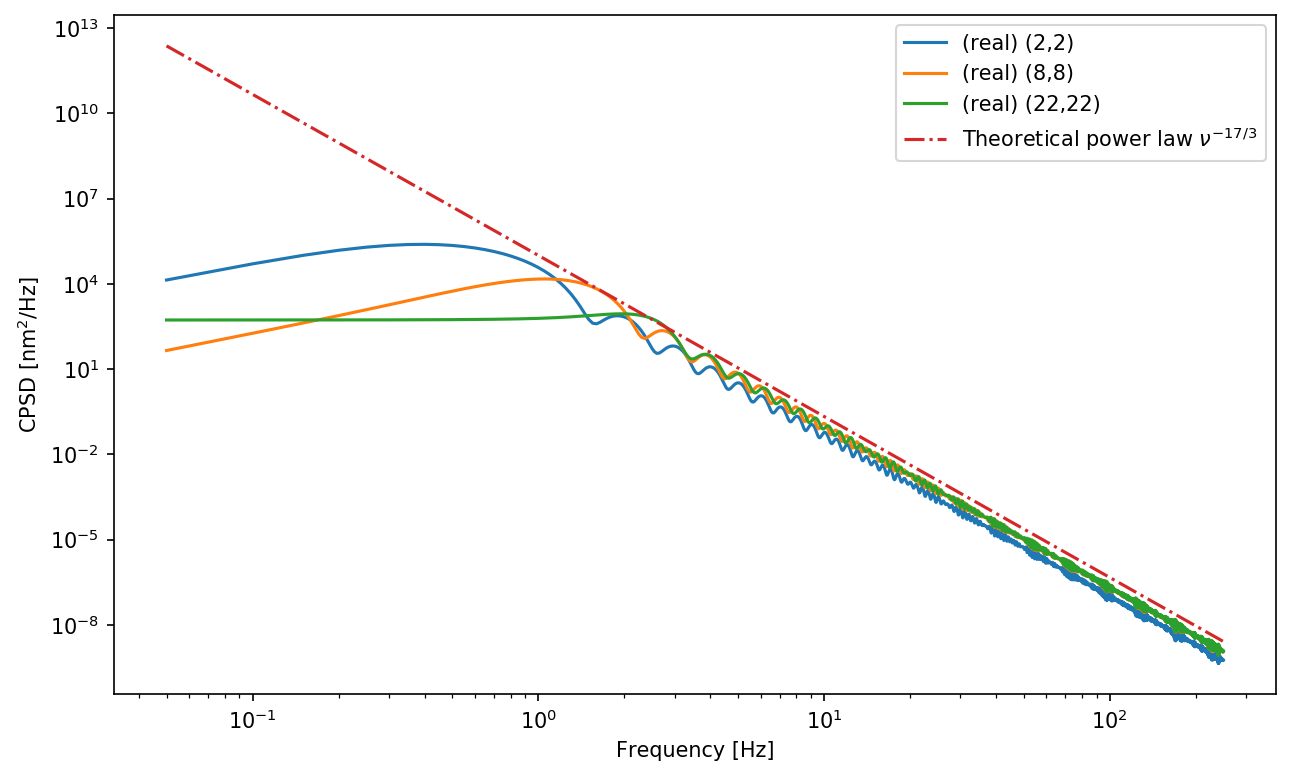
Slope of Zernike CPSD at low temporal frequencies¶
[43]:
import numpy as np
from arte.types.guide_source import GuideSource
from arte.types.aperture import CircularOpticalAperture
from arte.atmo.von_karman_covariance_calculator import VonKarmanSpatioTemporalCovariance
from arte.atmo.cn2_profile import Cn2Profile
rho, theta = (0,0)
aperture_radius = 5
aperture_centre = [0, 0, 0]
r0 = [0.16]
L0 = [25]
layers_altitude = [10e3]
wind_speed = [10]
wind_direction = [0]
source = GuideSource((rho, theta), np.inf)
aperture = CircularOpticalAperture(aperture_radius, aperture_centre)
cn2 = Cn2Profile.from_r0s(r0, L0, layers_altitude, wind_speed, wind_direction)
spatial_freqs = np.logspace(-3, 3, 100)
temporal_freqs = np.linspace(0.05, 250, 5000)
vk = VonKarmanSpatioTemporalCovariance(source1=source, source2=source, aperture1=aperture, aperture2=aperture,
cn2_profile=cn2, spat_freqs=spatial_freqs)
zz22 = vk.getZernikeCPSD(2, 2, temporal_freqs)
zz33 = vk.getZernikeCPSD(3, 3, temporal_freqs)
[45]:
plt.figure()
vk.plotCPSD(zz22, temporal_freqs, 'real', 'log', '(2,2)')
vk.plotCPSD(zz33, temporal_freqs, 'real', 'log', '(3,3)')
def slope(x, m, q):
return q*x**(m)
slp_positive = slope(temporal_freqs, 2, 5e6)
slp_negative = slope(temporal_freqs, -1/8, 2.7e5)
plt.loglog(temporal_freqs, slp_positive, '-.', color=cycle[0], label='$\\nu^{2}$')
plt.loglog(temporal_freqs, slp_negative, '-.', color=cycle[1], label='$\\nu^{-1/8}$')
plt.legend()
[45]:
<matplotlib.legend.Legend at 0x8253e48d0>

[ ]:
[ ]: